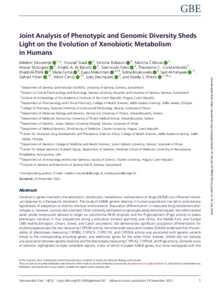وثيقة
Joint analysis of phenotypic and genomic diversity sheds light on the evolution of xenobiotic metabolism in humans.
المعرف
DOI: 10.1093/gbe/evac167
المصدر
Genome Biology and Evolution. v. 14, 12, evac167
المساهمون
Daali, Youssef., مؤلف
Rollason, Victoria., مؤلف
Čížková, Martina., مؤلف
Mulugeta, Anwar., مؤلف
Al-Balushi, Khalid A., مؤلف
Fakis, Giannoulis., مؤلف
Al-Thihli, Khalid., مؤلف
Černá, Marie., مؤلف
Makonnen, Eyasu., مؤلف
Boukouvala, Sotiria., مؤلف
Al-Yahyaee, Said., مؤلف
Yimer, Getnet., مؤلف
Černý, Viktor., مؤلف
Desmeules, Jules., مؤلف
Poloni, Estella S., مؤلف
الدولة
United Kingdom.
مكان النشر
Oxford.
الناشر
Oxford University Press.
ميلادي
2022-12-01
اللغة
الأنجليزية
الملخص الإنجليزي
Variation in genes involved in the absorption, distribution, metabolism, and excretion of drugs (ADME) can influence individual response to a therapeutic treatment. The study of ADME genetic diversity in human populations has led to evolutionary hypotheses of adaptation to distinct chemical environments. Population differentiation in measured drug metabolism phenotypes is, however, scarcely documented, often indirectly estimated via genotype-predicted phenotypes. We administered seven probe compounds devised to target six cytochrome P450 enzymes and the P-glycoprotein (P-gp) activity to assess phenotypic variation in four populations along a latitudinal transect spanning over Africa, the Middle East, and Europe (349 healthy Ethiopian, Omani, Greek, and Czech volunteers). We demonstrate significant population differentiation for all phenotypes except the one measuring CYP2D6 activity. Genome-wide association studies (GWAS) evidenced that the variability of phenotypes measuring CYP2B6, CYP2C9, CYP2C19, and CYP2D6 activity was associated with genetic variants linked to the corresponding encoding genes, and additional genes for the latter three. Instead, GWAS did not indicate any association between genetic diversity and the phenotypes measuring CYP1A2, CYP3A4, and P-gp activity. Genome scans of selection highlighted multiple candidate regions, a few of which included ADME genes, but none overlapped with the GWAS candidates. Our results suggest that different mechanisms have been shaping the evolution of these phenotypes, including phenotypic plasticity, and possibly some form of balancing selection. We discuss how these contrasting results highlight the diverse evolutionary trajectories of ADME genes and proteins, consistent with the wide spectrum of both endogenous and exogenous molecules that are their substrates.
ISSN
1759-6653
URL المصدر
قالب العنصر
مقالات الدوريات

